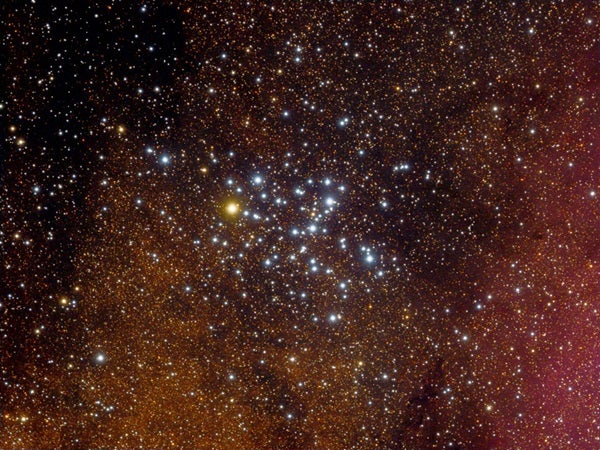Summertime, stargazing, and binoculars. In my mind, the three are inseparable. Is there anything better than sitting back with binoculars and scanning the summer Milky Way as it flows overhead? To start you off on your journey across the summer binocular universe, I’ve compiled a top 10 list of my favorite seasonal targets.
The Hero’s cluster
In May, we begin high in the eastern sky with the Hercules Cluster (M13). Aim a third of the way from brilliant Vega (Alpha [α] Lyrae) to Arcturus (Alpha Boötis), and you’ll see a faint smudge of light along the western side of Hercules’ dim Keystone asterism. Hard to believe, but what looks like a tiny ball of celestial cotton is actually a massive collection of more than 100,000 stars, which astronomers classify as a globular star cluster (because of its globe shape). M13 lies 25,000 light-years away.
Star clouds in Scorpius
The Butterfly Cluster (M6) and Ptolemy’s Cluster (M7) are two open star clusters in Scorpius. They sit near the stinger stars Shaula and Lesath (Lambda [λ] and Upsilon [υ] Scorpii) at the end of the Scorpion’s curved body. Place those stars at the bottom edge of your binoculars’ field of view, and you will see two distinct bundles of stars to their upper left.
M6, the smaller and more northerly of the pair, looks roughly rectangular. Some observers imagine that its stars form a butterfly’s outline, with two wings outstretched. The butterfly appears to be flying toward the southeast.
M7, mentioned by Greek philosopher Ptolemy around A.D. 130 and thus called Ptolemy’s Cluster, is larger and brighter than M6. Even through the smallest binoculars, several of the cluster’s stars show subtle hints of yellow and blue. The brightest is a golden sun lying near the group’s center.
The Archer’s lagoon
Shifting eastward, we arrive at the constellation Sagittarius the Archer, with its distinctive Teapot asterism. By scanning the Milky Way streaming northward from the Teapot’s spout, you’ll pass several bright clumps of starlight. The largest, which lies about a binocular field of view north of the spout, is a huge emission nebula called the Lagoon Nebula (M8).
The nebula appears lopsided, with the western side more bloated than the eastern half. If you have dark skies and a steady hand, you might spot the dark lagoon that divides the nebula in half. The magnitude 5.9 star 9 Sagittarii sits west of the lane.
A celestial swan
Farther north along the Milky Way in Sagittarius we come to the Swan Nebula (M17), another emission nebula. Look for it about 1½ fields of view north of the Teapot’s lid and just south of a yellowish 5th-magnitude star. With a magnification of 10x or more, look for a straight bar of light along the cloud’s northern edge. Can you also see a faint hook of nebulosity curving off the bar’s western end? It’s this hook-and-bar shape that gave rise to the Swan Nebula nickname.
A southern cotton ball
While many observers cite this list’s first object — M13 — as their favorite summer globular cluster, I prefer M22 in Sagittarius because of its aesthetics. M13 is isolated in Hercules, but M22 is right in the thick of the Milky Way. Look for its circular glow about half a binocular field northeast of Kaus Borealis (Lambda Sagittarii) at the Teapot’s top. Binoculars easily show a fuzzy halo surrounding a brighter core.
Like birds in flight
The Wild Duck Cluster (M11) sits in Scutum, but the easiest way to find it is to look 4° west-southwest of the magnitude 3.4 star Lambda Aquilae, one of the tail stars of Aquila the Eagle. M11 is one of the sky’s densest open clusters. More than 600 of M11’s stars shine brighter than 15th magnitude, but only a single 8th-magnitude rebel is bright enough to show through binoculars. The rest blend into a small, bright mist of starlight that looks more like a globular than an open cluster.
The sky’s dumbbell
Normally, planetary nebulae don’t show up well through binoculars because they appear so small. The Dumbbell Nebula (M27) is an exception. It looks distinctly rectangular through 10x binoculars, while higher magnifications hint at its characteristic hourglass profile. Look for it half a binocular field north of magnitude 3.5 Gamma (γ) Sagittae, the brightest star in Sagitta the Arrow.
Hang around these stars
The Coathanger (Collinder 399), which lies in Vulpecula the Fox, is one of my all-time favorite binocular objects. It’s easy to find if you look about two fields northwest of Altair, Aquila’s brightest star. Even a casual scan will immediately reveal the asterism’s unique shape. Ten stars glow brighter than 7th magnitude. Six in a straight line form its crossbar, and another four to the south curve to create the hook. Powers of 7x to 10x give the best view of the Coathanger dangling in a star-filled closet.
A continent in the sky
Our last object needs a dark sky, but once you spot it, it’s sure to become a favorite. Simply aim your binoculars toward Deneb in Cygnus, and look roughly half a field of view (3°) to its east. Can you see a slightly brighter, hook-shaped patch of Milky Way? That’s the North America Nebula (NGC 7000). The easiest part to see is the East Coast as it stretches from Long Island to Florida and then around to the Gulf of Mexico.
Enjoy each of these targets and then branch out on your own to discover more of what this season has to offer. Summer is made for binocular stargazing. And remember that, as always, two eyes are better than one.












